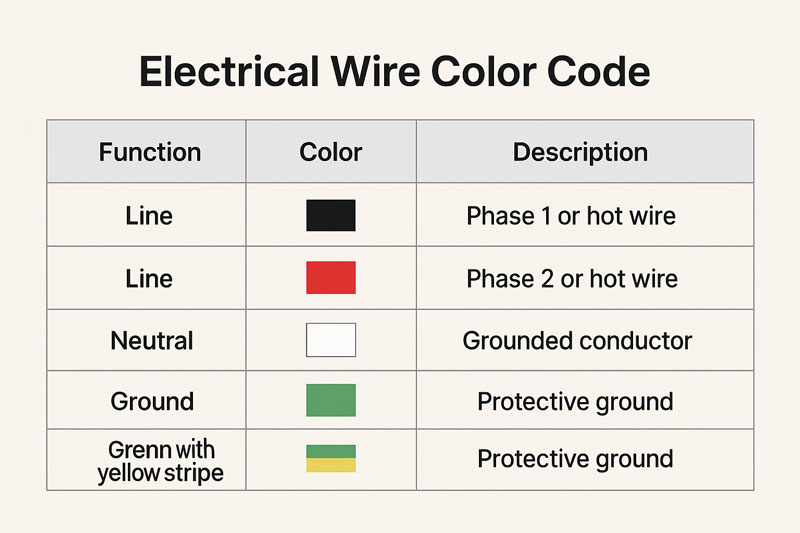When working with electrical systems, understanding the electrical wire color code is essential for both safety and compliance. Whether you're a DIY enthusiast or a professional electrician, knowing what each wire color means can help you avoid dangerous mistakes and ensure proper circuit connections. This guide breaks down the most common wire color codes used in residential, commercial, and industrial installations.

electrical wire color code
What Is an Electrical Wire Color Code?
An electrical wire color code is a standardized system that identifies the function of each wire in a circuit by its insulation color. These codes vary slightly by country or region, but their purpose is universal: to prevent accidents, simplify wiring, and comply with safety regulations.
View the Electrical Wire Color Code Chart (PDF)
To help you better understand the function and application of each wire color, we've created a clear and easy-to-read Electrical Wire Color Code Chart PDF. This downloadable chart outlines standard wire color codes used in residential, commercial, and industrial electrical systems—covering both U.S. and international standards.
📄 Click the link below to view or download the full PDF chart:
👉 Electrical Wire Color Code Chart PDF
This chart makes it easier to identify wire functions at a glance, reduce wiring errors, and improve both safety and efficiency in your electrical projects.
Standard Electrical Wire Color Codes (US & International)
1. United States (NEC – National Electrical Code)
| Wire Color | Function | Description |
|---|---|---|
| Black | Hot / Live | Primary power supply; used for phase 1 |
| Red | Hot / Live | Secondary hot wire; used for phase 2 or switch legs |
| Blue / Yellow | Hot (In conduits) | Travelers in 3-way switches or phase 3 |
| White / Gray | Neutral | Carries return current to panel |
| Green / Bare | Ground | Safety grounding wire |
✅ Tip: In 240V systems, black and red wires are typically used as dual hot wires.
2. IEC (Europe, Asia, etc.) Wire Color Code
| Wire Color | Function | Description |
|---|---|---|
| Brown | Line (L) | Live or hot wire |
| Blue | Neutral (N) | Return path of current |
| Green/Yellow | Earth / Ground | Protective conductor |
Electrical Wire Color Code in Different Applications
🔌 Residential Wiring
Black / Red: Hot wires for outlets, lighting, and appliances
White: Neutral wires connected back to the service panel
Green / Bare Copper: Grounding for safety
⚙️ Industrial 3-Phase Systems (US)
| Voltage | Phase 1 | Phase 2 | Phase 3 | Neutral | Ground |
|---|---|---|---|---|---|
| 208V | Black | Red | Blue | White | Green/Bare |
| 480V | Brown | Orange | Yellow | Gray | Green/Bare |
📌 Note: Always verify your panel or building’s wiring diagram—older installations may not match current standards.
Importance of Following Electrical Wire Color Codes
✔️ Safety
Misidentifying a wire color can result in electric shock, short circuits, or fires. Proper color coding prevents dangerous assumptions during maintenance or upgrades.
✔️ Compliance
Following wire color codes ensures compliance with NEC, IEC, or local codes. This is crucial for passing inspections and avoiding fines.
✔️ Troubleshooting
Color-coded wires make diagnosing issues and tracing connections much easier, saving time and reducing confusion.
Tips for Safe Wiring Practices
Always turn off power at the breaker before working with electrical circuits
Label wires when removing them from old devices or panels
Use a voltage tester to confirm wires are not live
Follow local codes and consult a licensed electrician for complex installations
Common FAQs About Electrical Wire Color Code
Q1: Can white wires be hot?
Yes, in some cases (e.g., switch loops), white wires are re-designated as hot. They should be marked with black tape to indicate the change.
Q2: Is it safe to use old wiring color codes?
While functional, old color codes may not comply with current regulations and can be confusing. It's best to rewire using updated standards where possible.
Q3: Do wire colors change outside the US?
Yes, Europe, the UK, Australia, and other regions follow the IEC color coding system, which differs from the US NEC system.
Conclusion
Understanding the electrical wire color code is critical for anyone involved in wiring, from homeowners to seasoned electricians. By following standardized color codes, you ensure safer installations, easier maintenance, and code compliance.
If you're ever in doubt about your wiring system, consult a qualified electrician or refer to your local electrical code authority. Staying informed and cautious can prevent serious accidents and protect your property and equipment.
Need Help with Wiring or Cable Products?
At Tot wire and cable, we provide high-quality, code-compliant electrical wires for residential, commercial, and industrial projects. Contact us for expert advice and competitive pricing on all your cable needs.





